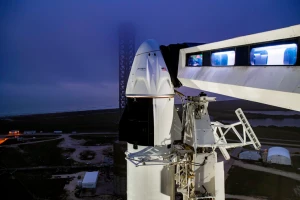- SPACE
- 1 year before
Firefly's Rapid Launch Strategy Redefines Space Missions
Discover how Firefly Aerospace's commitment to responsive launch operations for the Alpha rocket is revolutionizing space missions for commercial and government sectors
-

- 1 year before
- Category: SPACE
- Published: 04/02/2024

Firefly Aerospace is setting a new standard in the launch industry with its commitment to responsive launch operations, as demonstrated in the successful Victus Nox mission for the U.S. Space Force. Conducted on September 14, the mission showcased Firefly's capability to rapidly integrate and launch a satellite, completing pre-launch preparations in just 24 hours, a benchmark the company aims to maintain for future Alpha rocket launches. This approach not only enhances operational efficiency but also provides significant flexibility for both commercial and government clients.
Brett Alexander, Chief Revenue Officer at Firefly, emphasized the importance of maintaining this swift pace for upcoming missions, highlighting the benefits of a more agile launch process. The company's ability to respond quickly to launch requests was evident during the Victus Nox mission, where a 27-hour notice from the Space Force led to a successful satellite deployment.
Despite a partial success in a subsequent technology demonstration satellite launch on December 22, due to a second-stage anomaly, Firefly remains optimistic. The company is actively investigating the issue, with a focus on understanding and rectifying the root cause to prevent future occurrences. Bill Weber, Firefly's CEO, assured stakeholders that the investigation is progressing well and corrective actions are forthcoming.
Looking ahead, Firefly is not slowing down. It plans to conduct four Alpha launches this year, maintaining its launch cadence despite the December mishap. Moreover, Firefly, in collaboration with Northrop Grumman, is developing two new launch vehicles: the Antares 330 and the Medium Launch Vehicle (MLV). These vehicles aim to fill a gap in the medium-lift market, offering capabilities comparable to those of the Soyuz and Delta 2 rockets. With a focus on responsive operations, Firefly is poised to revolutionize the launch services market, delivering unparalleled flexibility and speed to satellite deployment missions.
What is Firefly Aerospace's latest innovation in launch operations?
Firefly Aerospace has introduced responsive launch operations, aiming to make this rapid deployment approach the standard for future Alpha rocket missions. This method significantly reduces the time from notification to launch, demonstrating a notable advancement in space mission efficiency.
How did Firefly Aerospace demonstrate its responsive launch capabilities?
Firefly Aerospace showcased its responsive launch operations through the Victus Nox mission for the U.S. Space Force, successfully placing a satellite into orbit just 27 hours after receiving formal notice, a timeline that emphasizes their commitment to rapid deployment.
What are the future plans for Firefly Aerospace's launch operations?
Firefly plans to apply the responsive launch procedures demonstrated in the Victus Nox mission to future launches, catering to both commercial and government customers. This approach aims to maintain a quicker pace in launch operations, enhancing the efficiency of space missions.
What happened in Firefly Aerospace's launch after Victus Nox?
Following the Victus Nox mission, Firefly attempted another Alpha launch, which resulted in a partial success due to the vehicle’s second stage not properly relighting. Despite this, the mission achieved many objectives, and a thorough investigation into the mishap is underway.
What new launch vehicles is Firefly Aerospace developing?
In collaboration with Northrop Grumman, Firefly is working on two new launch vehicles: the Antares 330, featuring a new first stage with Miranda engines, and the MLV, which offers medium-lift capacity. These developments are part of Firefly's strategy to fill a current void in the marketplace for responsive, medium-lift launch capabilities.





Write Comment